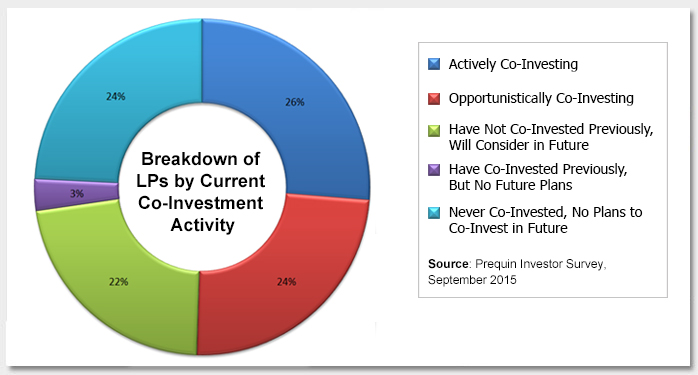More and more institutional investors consider co-investments1 an important part of their overall private equity portfolios. According to a September 2015 survey, Prequin interviewed 222 active Limited Partners (LP) about their co-investment activity and found 50% currently co-invest and an additional 22% have plans to invest alongside General Partners (GP) in the future. This indicates a vast majority of LPs have targeted or plan to target co-investments and see the structure as an attractive way to access private assets.
LP interest in co-investment opportunities has increased due to a number of factors, including:
- the need to lower the overall cost of accessing private assets (a typical fund charges a 2% management fee and 20% carried interest; a typical co-investment has a low- or no-fee structure);
- the ability to better control the pace of capital deployment;
- the potential to mitigate the J-Curve2;
- the desire to control their own risk.
Co-investing has the added benefit of allowing LPs to better understand, and potentially get better access to, the GPs they co-invest alongside.
The primary driver behind GPs offering co-investments is deal size. In some cases, deal sizes have grown relative to fund size, and so additional capital is required. In others, fund and deal sizes have held steady over successive fund cycles. However, given the tighter credit markets, GPs are not able to use as much debt financing as they had prior to the financial crisis, necessitating the need for additional equity investment. Co-investments allow GPs to address this capital shortfall while building stronger relationships with their LPs. It also has the benefit of allowing GPs to invest without the negative implications that may come along with syndicating a deal with other GPs (ex. ceding control, potential return reduction, and/or timing difficulties regarding decision making).
However, like many other things in life, co-investments are not a “free lunch” for LPs. In fact, Harvard University professor and well-respected private equity academic, Josh Lerner, co-wrote a paper that found, despite their substantial fee discounts, co-investments have historically underperformed traditional fund investments. Many LPs have had a much more positive experience. In fact, 97% of respondents in the previously mentioned Prequin survey reported their co-investments performed at least as well as their fund investments. Eighty percent reported co-investment returns that exceeded those funds. The difference between the two conclusions is likely, at least in part, the ability of LPs to analyze and source co-investment opportunities. Co-investing requires resources similar to those found in many private equity shops, including expertise in both underwriting and monitoring these investments. The attainment of the level of expertise required to do this well typically requires an investment in both people and technology to prudently manage such an endeavor.
Key Takeaway: Done right, co-investments can help LPs lower the costs, control the risks, and potentially increase the returns of their private equity portfolios. Given the complexity of co-investment opportunities and the limited timeframe to analyze deals, it is crucial that LPs have the appropriate resources and expertise in-house to handle them. A strong team with a proven and consistent due diligence and selection process can go a long way toward helping LPs avoid adverse outcomes in their co-investment activities and help enhance overall private market returns.
1. A minority investment made directly into an operating company, alongside a financial sponsor or other private equity investor. 2. The J-Curve illustrates the tendency of private equity funds to deliver negative returns and cash flows in the early years and investment gains and positive cash flows later in the investment fund’s life as the portfolio companies mature and are gradually exited.The material provided here is for informational use only. The views expressed are those of the author, and do not necessarily reflect the views of Penn Mutual Asset Management.
This material is for informational use only. The views expressed are those of the author, and do not necessarily reflect the views of Penn Mutual Asset Management. This material is not intended to be relied upon as a forecast, research or investment advice, and it is not a recommendation, offer or solicitation to buy or sell any securities or to adopt any investment strategy.
Opinions and statements of financial market trends that are based on current market conditions constitute judgment of the author and are subject to change without notice. The information and opinions contained in this material are derived from sources deemed to be reliable but should not be assumed to be accurate or complete. Statements that reflect projections or expectations of future financial or economic performance of the markets may be considered forward-looking statements. Actual results may differ significantly. Any forecasts contained in this material are based on various estimates and assumptions, and there can be no assurance that such estimates or assumptions will prove accurate.
Investing involves risk, including possible loss of principal. Past performance is no guarantee of future results. All information referenced in preparation of this material has been obtained from sources believed to be reliable, but accuracy and completeness are not guaranteed. There is no representation or warranty as to the accuracy of the information and Penn Mutual Asset Management shall have no liability for decisions based upon such information.
High-Yield bonds are subject to greater fluctuations in value and risk of loss of income and principal. Investing in higher yielding, lower rated corporate bonds have a greater risk of price fluctuations and loss of principal and income than U.S. Treasury bonds and bills. Government securities offer a higher degree of safety and are guaranteed as to the timely payment of principal and interest if held to maturity.
All trademarks are the property of their respective owners. This material may not be reproduced in whole or in part in any form, or referred to in any other publication, without express written permission.


